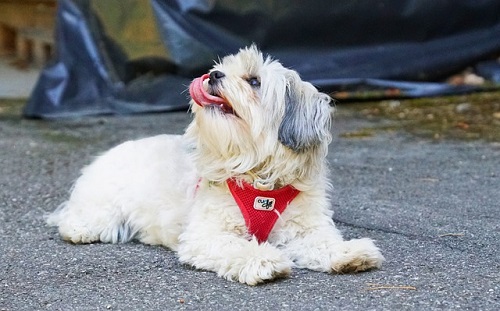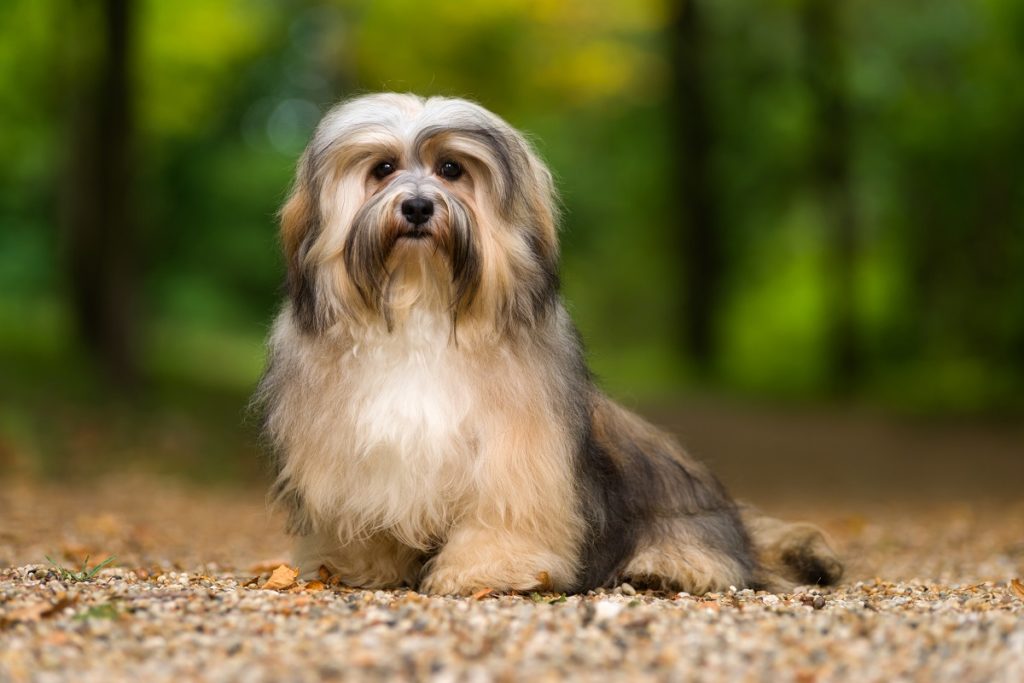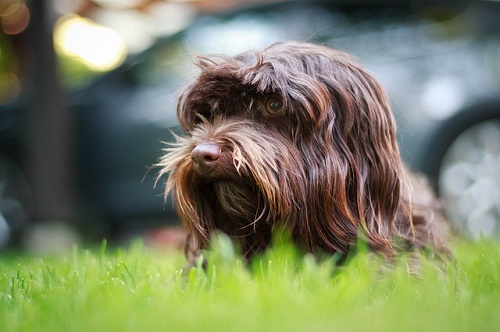The Havanese is a dog breed that might not be familiar in name, but is instantly recognizable in person. The long, silky coat they wear gives them the appearance that they are floating as they walk, and the additional “poof” of their tail, which curls back up over the body, adds a touch of elegance. They are very popular city dogs due to their smaller size and friendly, outgoing nature, and will generally grow no larger than about 15 pounds – rendering them ideal pets for apartment, condo, and townhouse dwellers. Dog owners of this breed say that the Havanese personality is affectionate, loving, and impressively intelligent.
Havanese dogs have the distinction of being the only dog breed that is native to the country of Cuba; however, very few realize this well-loved pup actually hails from Latin America. The Havanese is a descendant of a now-extinct breed called the Blanquito de la Habana, or “little white one from Havana.” Today, this Bichon-relative breed may not have the curly coat of his cousins, but he certainly shares their enthusiasm and energy. This article will explore the jovial breed, described by the AKC as “intelligent, outgoing and funny”, including the Havanese temperament and disposition, health conditions, grooming tips, and other essential info for pet parents.
Are Havanese Dogs Friendly?
The big, bright eyes of a Havanese are a great indicator of his temperament: he’s not just outgoing, he’s earned the nickname of “Velcro dog” because he’s predisposed to stick like glue to his human parent. Unless a new person or animal is unexpectedly in his personal space, a Havanese is far more likely to give a wag of that unique curled-up tail than anything approaching aggression. He loves attention and adores company, making him an ideal lap dog for a stay-at-home pet parent or an elderly owner that loves canine cuddles.
As a toy-breed companion dog, Havanese dogs are smaller with sturdy bodies and a light, springy step that makes them recognizable among other Bichon-type breeds. That said, as much as they love companionship, it’s important not to pair them with a much larger canine sibling without adequate supervision. Even friendly breeds like the Havanese do have their limits, and setting them loose in a yard or in a room with a larger dog could lead to mishaps and injuries. The same caution should be used when serving food to dogs or offering them a single new toy to play with – equality helps keep canine tempers from flaring in competition.
As a walk-around-town companion, a Havanese is ideal – he isn’t typically put off by large crowds or a lot of noise as long as his pet
parent is nearby. He’s just as happy to stroll down the avenue looking for pats from passers-by as he is to curl up on the couch next to his parent and snooze. He’s also large enough to be walked on a leash and collar, but small enough to be picked up and carried where necessary.
Are Havanese Dogs Good For Allergies?
Many humans that are allergic to dogs are actually allergic to their dander – the dried flakes of skin and sweat that become airborne as a dog sheds his coat. Although they’re not ‘hypoallergenic’, per se, the Havanese is considered a non-shedding breed, despite its luxuriously long double-layer coat. Because the hair stays put, allergy sufferers don’t have to worry about breathing in the small, tickling fur and dander common to smaller breeds. They can pet, cuddle, and enjoy their dog’s company to their heart’s content. This is a particularly great benefit for homes that have an asthmatic pet parent or a child in the family that may be allergy-sensitive to other dog breeds.
Havanese Health Problems: What Pet Parents Should Know
Happily, Havanese pooches are uniquely hardy among toy breeds and tend to have few breed-specific problems. Like many smaller
dogs, he can carry a tendency towards knee and hip/joint issues in his genetics that may manifest as he grows older; pet parents should pay close attention to how readily he climbs stairs, or if he appears to be hesitant or reluctant to walk.
This isn’t to say that the Havanese breed is entirely free of complications, however. Much like his Bichon-related breed cousins, he can have sight and canine hearing loss; these are usually selectively bred out in purebred lines, but recessive genes do emerge at times. When a Havanese is undergoing his periodic checkup at the vet’s office, it’s prudent for his pet parent to ask about an eyesight and hearing assessment to make sure he’s free of these issues.
Housebreaking A Havanese: A Dog Owner’s Checklist
A Havanese dog is a pup that’s very eager to please and extremely praise and attention-oriented. In this sense, he can easily be instructed which phrases and time periods usually mean “potty-time,” and as long as his parent is timely about walking him, accidents should be minimal. That said, the tendency of this loving “Velcro” dog to cling to his parent’s side is a breed recipe for canine separation anxiety. It’s also, unfortunately, a trigger for the stress urination and defecation that go hand in hand with this trait.
Training experts agree: a Havanese is not a good pet option for owners that plan to be away from home habitually. In addition to the small size of the dog – and his bladder – necessitating frequent bathroom breaks, it’s not uncommon for him to experience pronounced anxiety and depression when left to his own devices. If a pet parent isn’t able to stay with the dog during the day, it may be a good idea to ask friends, relatives, or pet sitting professionals to stay with the dog or at the very least, check in with him frequently. If leaving him alone is unavoidable, leave a television or radio on for comfort, and place an unwashed piece of clothing in his sleeping area to soothe him with a caregiver’s scent.
In terms of the actual housebreaking training, small, soft treats are an excellent and easy-to-remember incentive for him to do his business. These treats should be carried in a pocket or bag and used liberally when he:
- Initially responds to his name and comes when he’s called.
- Sits still to have his leash attached and readied for a walk.
- Stays by his parent’s side and walks where he’s guided.
- Right after he eliminates in the correct area.
 The treats are a way to connect what he should be doing outside – going to a certain place and going potty – and doing it on command/his parent’s timeline. Whenever possible, use the phrase chosen to represent this chore – “go potty/pee/poop”, etc. – and give him his treat directly after he does so. That rhythm of phrase/action/recognition is the cycle that will reinforce the behavior and help teach him that it is “wrong” to go on the carpet inside.
The treats are a way to connect what he should be doing outside – going to a certain place and going potty – and doing it on command/his parent’s timeline. Whenever possible, use the phrase chosen to represent this chore – “go potty/pee/poop”, etc. – and give him his treat directly after he does so. That rhythm of phrase/action/recognition is the cycle that will reinforce the behavior and help teach him that it is “wrong” to go on the carpet inside.
If a Havanese calls an apartment home, he may not have a yard full of grass to use when he hears nature’s call. In this case, a pet parent should be prepared to set up a safe place for him to do his business inside. This area will need to be kept free of mess and debris, and cleaned immediately if he uses it. If housebreaking a Havanese entirely indoors, these points should also be considered:
- A non-porous, tiled or linoleum floor minimizes mess and makes sanitation easier: E.g., bathrooms, laundry rooms, etc. This room can also be used to confine him when he needs to be left alone or put to bed.
- Puppy pads or “wee-wee pads” offer a clear advantage over substances such as newspaper: These pads are waterproof on one side and porous on the other, soaking in and trapping liquids and odors. Buy larger sizes to make cleanup easier, even when faced with poor aiming on the part of the pup.
- Failing to clean up potty messes will encourage bad habits on his part: If he sees or smells his own waste, he may get the idea that everything is fair game – marking the corners of furniture or walls and pooping in carpeted areas. Dogs mark their territory with scent and waste, and if he’s already “gotten” his designated potty area, he might feel bold enough to mark elsewhere.
- He may need a little help cleaning himself up, too: There’s no easy way to put it: a Havanese has a long, luxurious coat everywhere. This means that an elimination may leave his backside a little messy – in-the-know Havanese parents keep doggy bathroom wipes on hand to make sure any mess stays on the disposable pads, not on his rear end.
- Neutering or spaying will help with “competition marking” between canine siblings: Sibling rivalry can be very different (and a little more gross) between dogs than between humans. Because he marks his territory with urine, his sibling urinating on top of that pee is essentially saying “no, MINE.” This can go back and forth several times depending on how stubborn each dog is – outside, it may be amusing, but indoors, it’s a nightmare. Neutering a Havanese at the appropriate age will help tamp down the hormones that precipitate this behavior, and hopefully keep any urine-based territory battles to a minimum.
Does A Havanese Dog Need Grooming?
While professional or even frequent home grooming is optional for some short-coat dog breeds, it’s absolutely essential for the Havanese. He has a soft, non-shedding double coat, which is similar to stacking a wig on top of another wig – it looks great as long as it doesn’t get tangled. Unfortunately, it does get tangled – he’s an energetic breed that wants to play and explore, and that comes with knots galore.
If a Havanese isn’t brushed thoroughly a minimum of twice a week, painfully large tangles called mats will form, and continue to grow and knot as they pull at the skin. If they get out of control, they’ll need to be cut away, leaving chunks and gaps in his coat that affect temperature regulation. To avoid these canine fur mats, a pet parent can instruct their professional groomer to cut his coat short or close to the skin; this will reduce much of the bulk of his silhouette but will have no ill effects on his health provided he remains in a temperate environment. 
When a professional grooming is made for a Havanese, the groomer should be instructed to perform what’s called a “hygiene cut” around his genitals and lower stomach. This eliminates long strands of his coat from hanging down and getting dirty when he does his business, helping pet parents avoid messy headaches. Most groomers can also help with anal gland expression – a manual cleaning of the dirt, oils, and body fluids that build up in special glands on either side of a dog’s bottom. This expression will keep him feeling clean, healthy, and happy until his next appointment under the clippers.
Some Havanese dogs, particularly those with white coats, do experience the brown streaks of “tear staining” common to Lhasa Apsos, Poodles, Bichon Frises, and similar toy breeds. This isn’t generally a cause for concern health-wise, but any reputable groomer can make suggestions for shampoos or serums that will eliminate the staining.
Ideally, a Havanese should have both grooming attention from his pet parent(s) as well as grooming appointments at regular intervals. Experiment with different brush styles to find the one that works for him and removes dead fur without causing him pain or discomfort. This brushing routine can be made a part of time spent together, helping him control and manage his separation anxiety if he needs to be left alone at any point.
Caring For Sociable & Trainable Havanese: Love, Patience & Affection
The Havanese is a handsome, elegant, and beautiful example of a toy breed with lots of love to give. He will return the adoration of his beloved parent(s) tenfold, so long as they promise not to be gone at the store for too long. While they do need patience and a firm, consistent tone for training to “sink in,” once they get the basics they’re eager to please by repeating them on demand.
Sources Cited:
- “Havanese Dog Breed Information and Personality Traits.” Hill’s Pet.com (no publish date), https://www.hillspet.com/dog-care/dog-breeds/havanese. Accessed September 22, 2019.
- Welton, Michele; Dog Trainer, Behavioral Consultant, Author. “Havanese: What’s Good About ‘Em, What’s Bad About ‘Em.” Your Purebred Puppy.com, July 21, 2019, https://www.yourpurebredpuppy.com/reviews/havanese.html. Accessed September 22, 2019.
- “The Havanese: A Happy Spirit Sure to Make You Smile!” CertaPet.com, August 13, 2019, https://www.certapet.com/havanese/. Accessed September 22, 2019.
- “Havanese Health Problems.” Dog Breeds Experts.com, (no publish date), https://www.dog-breeds-expert.com/havanese-health-problems.html. Accessed September 22, 2019.
- “Havanese.” American Kennel Club (AKC.org), (no publish date), https://www.akc.org/dog-breeds/havanese/. Accessed September 22, 2019.





